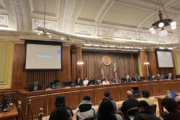Virginia’s ratification of the Equal Rights Amendment this week represents not only a potential milestone for the ERA’s century-long struggle but also a remarkable evolution for a state that for decades had blocked the legislative effort to empower women.
Virginia, one of the few states to originally reject the 19th Amendment giving women the right to vote, fell one vote short in 1982 of passing the ERA, which would ban discrimination on the basis of sex and guarantee equality for women under the Constitution.
But a multi-generational effort by progressives and feminists, coupled with shifts in Virginia’s political landscape in recent years, finally made the ERA a reality in the commonwealth.
Although a lengthy court fight awaits in the effort to either enshrine or block the ERA’s addition to the Constitution — federal lawsuits have been filed so far in Alabama, Massachusetts and Washington, DC — that didn’t dampen emotions in Virginia’s Statehouse when the final votes were cast on Monday.
“Passage of the Equal Rights Amendment today is a result of women coming together over decades, refusing to suffer in silence as we are discriminated against, paid less and subjected to gender-based violence,” Democratic Del. Jennifer Carroll Foy, the chief patron of the Virginia House bill, said Monday.
One vote short
Congress passed the ERA in 1972, sending it to the states for ratification within a seven-year deadline. Although some states immediately passed it, activists in Virginia quickly came to realize it would be tough to ratify in what was then a solidly conservative state.
So they worked to elect like-minded candidates to a state legislature that was almost entirely male, recalled Emily McCoy, a former activist with the National Organization for Women’s Virginia chapter, which pushed for the ERA.
Tensions rose as the deadline approached and Virginia still hadn’t ratified. Two NOW leaders, Marianne Fowler and Jean Marshall Clarke, were arrested at the Virginia state Capitol, protesting after a House committee voted to kill the ERA, according to a 1978 Washington Post report. Fowler refused to leave the Capitol and in frustration spat on the officer who dragged her out.
Efforts became even more aggressive after Congress voted to extend the ratification deadline to 1982.
A number of pro-ERA female activists, mostly from Virginia, formed “A Group of Women” and began organizing public acts of civil disobedience to draw attention to the ERA, including chaining themselves to the White House in 1981, according to Megan Taylor Shockley’s book, “Creating a Progressive Commonwealth.” A year later, on Susan B. Anthony’s birthday, 10 of the group’s women scaled the White House fence — attempting to deliver an ERA petition to President Ronald Reagan — and were arrested, Shockley wrote.
In February 1982, Virginia fell a vote short in the state Senate of passing the ERA after a Republican senator, Nathan Miller, took a business trip to avoid voting on the amendment, Shockley wrote.
“The world doesn’t stop because the General Assembly starts,” Miller told the Post at the time.
Fowler and another activist, Pat Winton, chased Miller down at the Richmond airport to try to prevent him from leaving, according to Shockley.
A news report quoted Fowler as saying the senator had looked “sheepish” when they caught up with him, and he avoided them by ducking into the men’s room, Shockley wrote. Miller didn’t respond to a CNN request for an interview.
Falling one vote short was a feeling of “intense disappointment,” McCoy told CNN, adding that they had been let down when some candidates promised support for the ERA, only to change their minds once elected.
“We all kept up a strong front and kept our emotions in check. There had been a number of disappointments before then. There was no demonstration as a group or as individuals to show our disgust,” she recalled.
Activists tried to keep the ERA alive by filing suit in the Virginia Supreme Court, which did not take up the matter, according to Shockley. By the June 1982 deadline, only 35 states had ratified the ERA — three shy of the threshold needed to add it to the Constitution — and five that had previously passed it by then had rescinded their support, throwing its future into serious doubt.
A new legal theory
The ratification of the 27th Amendment, a congressional pay measure first proposed by James Madison, in the early 1990s helped reawaken efforts to ratify the ERA, said Eileen Davis, a co-founder of the pro-ERA group Women Matter.
The argument went like this: The 27th Amendment, which had been approved by a handful of states in the 18th century, had been dormant for more than 200 years before it was dusted off and finally ratified by the remaining necessary number of legislatures. For ERA hopefuls, that awakened the legal theory that despite the since-passed 1982 deadline, the states’ ratifications remained valid. As for the states that had rescinded their support, advocates say such moves have no legal standing.
All that was needed, so the belief went, was the blessing of three more states to get to 38 to add the amendment to the Constitution.
But although Virginia’s legislature was under Democratic control in the early 1990s, supporters’ case “had not yet been developed to the point of being a fully formed argument for ERA ratification,” McCoy said. And there were Democratic legislators who were conservative and worked hard to block the ERA, former Del. Karen Darner said.
Over the next few years, Republicans steadily gained control of the legislature, further dimming the ERA’s prospects.
Advocates, however, never gave up. Around 2011, Davis, fellow activist Candy Graham and political strategist Andrea Miller began lobbying the Virginia legislature to ratify the ERA. Although it passed in the Senate, the resolution died in the Republican-controlled House.
That pattern repeated for several years: The ERA got through the Virginia Senate, only to be stifled in a GOP-controlled House committee.
The final push
But Virginia’s politics were changing. Barack Obama in 2008 became the first Democrat to carry the commonwealth since Lyndon Johnson in 1964, and the state has voted Democratic in the two presidential races since. Today, seven of its 11 members of Congress are Democrats, as are both of its US senators.
And the political winds across the nation have shifted. A swirl of factors — including an increasing cultural belief in the need for equal women’s rights, progressive fury over President Donald Trump and his history of misogynist comments, the #MeToo movement — helped bring newfound attention to the ERA, which was ratified in Nevada and Illinois in 2017 and 2018, respectively.
“We are seeing another wave of activism in recent years. I think the resurgence of female activism in the past few years around Black Lives Matter, around the #MeToo movement, around a recognition that there’s still systemic sexism and gender-based discrimination in our society, has renewed the call for the passage of the Equal Rights Amendment to enshrine equality for women in our Constitution,” said Dr. Karen Sherry, the Virginia Museum of History & Culture’s collections curator.
Just as important, Trump’s election galvanized Democrats, who in Virginia made significant advances in the 2017 state elections before taking over both chambers of the legislature last November.
This time, there would be no stopping the ERA in Virginia.
“We needed to have the numbers in the General Assembly. … That’s been where the real obstruction has been,” Carroll Foy said.
Also boosting the momentum was a leading role from women of color. The three “chief patrons” of the resolutions — Carroll Foy and Democratic state Sens. Jennifer McClellan and Mamie Locke — are all black.
African American women, who have “not been a welcome voice whenever you’re talking about equality,” stand to benefit the most from the ERA, Carroll Foy told CNN.
Almost immediately after the November election, making good on their promises, Democrats prefiled the ERA resolutions in the House and Senate. They were introduced in early January as HJ 1 and SJ 1 — a symbolic reflection of Democrats’ priority in getting them passed.
The measures steadily climbed through the legislature throughout the month before the last step of ratification was completed on Monday. A handful of Republicans crossed party lines to vote in favor.
For ERA advocates, it was the culmination of a fight decades in the marking — even if they’re well aware of the legal battles that lie ahead.
“I felt a lot of relief and joy,” Kati Hornung, a campaign coordinator for the grassroots campaign VARatifyERA, told CNN of Monday’s vote.
But, she added, “I know we still have a lot of work to do.”







